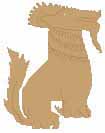G r a n d I d e a s
N e w P l a n s
N e w P l a n s
N e w P l a n s
A New Strategy
photo caption
Aircraft over Burma. Air power gave the Chindits a certain strategic freedom of maneuver by not tying them to ground lines of communications. But the force was also limited in tactical mobility by the speed of soldiers & pack animals moving on the ground.
Photograph courtesy of
the Imperial War
Museum, London
Wingate arrived back in London in early August. He immediately met with the Army Chief of Staff General Alan Brooke and then was whisked to the Prime Minister. Over dinner, Churchill listened to Wingate's stories of the Chindits and how given the resources and manpower Long-Range Penetration could help defeat the Japanese. Impressed, he wrote, "We had not talked for half an hour before I felt myself in the presence of a man of the highest quality. He plunged into his theme of how the Japanese could be mastered in jungle warfare by long range penetration groups landed by air behind enemy lines. This interested me greatly. I wished to hear more about it, and also to let him tell his tale to the Chiefs of Staff. I decided at once to take him with me on the voyage."1 The voyage would be to the Allied Quadrant Conference at Quebec in mid-August, where future Allied war strategy was to be formulated.
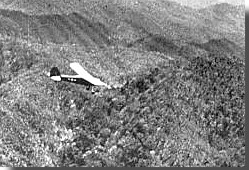
 At Quebec the British & Americans disagreed over political considerations & war strategy. But when it came time to discuss Burma, the U.S. goal to establish the long-desired land line to China prevailed. Churchill agreed action was needed and Wingate was along to help sell the strategy and to help Churchill establish a more harmonious mood of cooperation. Before the top Allied military and political leaders Wingate was given the opportunity to present his ideas for using Chindit units as part of the overall plan for the defeat of the Japanese. He proposed inserting six brigade-sized Long-Range Penetration units behind Japaneselines against major lines of communications on the central Chindwin front & in northern Burma. There, in timed conjunction with offenses by the British in the west and Chinese forces from the northwest and east, his force strategically placed would substantially weaken the enemy. A decisive strategic decision would be forced, northern Burma would be taken so securing the air and land line to China, and a base for future operations established. As his memorandum stated, "Long Range Penetration affords greater opportunity of mystifying and misleading the enemy than any other form of warfare...To sum up, LRG [Long Range Groups] should be used as an essential part of the plan of conquest to create a situation leading to the advance of our main forces."2
His confidence
and daringness of the plan impressed his audience. Churchill was favorably impressed, writing Wingate would create, "vigor and inventiveness in this decayed Indian scene."5 The Americans were impressed by Wingate's vision and desire to fight the Japanese. Said the U.S. Army Air Force Chief of Staff Hap Arnold, "You took one look at that face, like the face of a pale Indian chieftain, topping the uniform still smelling of sweat and war, and you thought: ‘Hell, this man is serious.'"6 The combined military chiefs of staff approved his idea. Hearing of the fate of having to leave the wounded behind in his campaign, Arnold offered Wingate an air force unit to assist with transportation & air support. And Churchill was promising his personal backing if any problems were placed in his way.
At Quebec the British & Americans disagreed over political considerations & war strategy. But when it came time to discuss Burma, the U.S. goal to establish the long-desired land line to China prevailed. Churchill agreed action was needed and Wingate was along to help sell the strategy and to help Churchill establish a more harmonious mood of cooperation. Before the top Allied military and political leaders Wingate was given the opportunity to present his ideas for using Chindit units as part of the overall plan for the defeat of the Japanese. He proposed inserting six brigade-sized Long-Range Penetration units behind Japaneselines against major lines of communications on the central Chindwin front & in northern Burma. There, in timed conjunction with offenses by the British in the west and Chinese forces from the northwest and east, his force strategically placed would substantially weaken the enemy. A decisive strategic decision would be forced, northern Burma would be taken so securing the air and land line to China, and a base for future operations established. As his memorandum stated, "Long Range Penetration affords greater opportunity of mystifying and misleading the enemy than any other form of warfare...To sum up, LRG [Long Range Groups] should be used as an essential part of the plan of conquest to create a situation leading to the advance of our main forces."2
His confidence
and daringness of the plan impressed his audience. Churchill was favorably impressed, writing Wingate would create, "vigor and inventiveness in this decayed Indian scene."5 The Americans were impressed by Wingate's vision and desire to fight the Japanese. Said the U.S. Army Air Force Chief of Staff Hap Arnold, "You took one look at that face, like the face of a pale Indian chieftain, topping the uniform still smelling of sweat and war, and you thought: ‘Hell, this man is serious.'"6 The combined military chiefs of staff approved his idea. Hearing of the fate of having to leave the wounded behind in his campaign, Arnold offered Wingate an air force unit to assist with transportation & air support. And Churchill was promising his personal backing if any problems were placed in his way.
Allied strategy agreed upon called for a campaign to seize northern Burma in the dry season of 1944, "To carry out operations for the capture of Upper Burma in order to improve the air route and establish overland communications with China."7 A new regional command headquarters, SEAC (South-East Asian Command), was established to control Allied forces on the India-Burma front. It would have a new commander in British Admiral Louis Mountbatten, replacing Wavell who had lost Churchill's confidence. One British army corp was to drive eastward from India into central Burma towards the Chindwin, while another attacked into the south. Led by the new army commander General Slim, their purpose would be to pin down Japanese forces and preventing them from operating against a northern offense. This would see General Stilwell leading an American trained & equipped Chinese force of several divisions out of Ledo in northeast India into northwest Burma, advancing down the Hukawng Valley to seize the northern towns of Mokaung & Myitkyina. A road would be built behind Stilwell’s advancing force through Myitkyina to connect to the northern part of the old Burma Road. A Chinese army would attack into eastern Burma from across the Salween River & seize this northern line of the Burma Road. Once the two forces linked up, the ground supply line to China would be opened. Supplies & equipment could begin flow to equip Chinese armies & fuel American bombers on Chinese soil. Wingate was to raise a force of six brigades & to cut the supply lines in northern Burma to the Japanese forces fighting Stilwell and the other Chinese force. Officially labeled 3rd Indian Division-Special Forces (but known as the Chindits), they would go in by foot & air. Wingate would command with the rank of Major-General.
photo caption
The new theater commander Admiral Mountbatten, General Stilwell, General Wingate. Both were impressed by Wingate's zeal. All three new the value of publicity.
Photograph courtesy of
the Imperial War
Museum, London
Fighting for Support
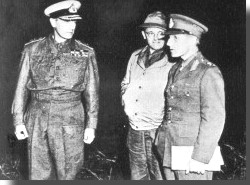
 Returning to India in September, Wingate's was fully determined to remove any obstacles to the fulfillment of his mission. As his new chief-of-staff Colonel Tulloch put it, "Wingate regarded his own promise to Roosevelt and Churchill that Northern Burma would be recaptured down to the 24th parallel before the monsoon of 1944 - as a sacred mission to be accomplished at all costs. Those who opposed his mission he hereafter regarded as the King's Enemies."8 The command in India had argued during the Quebec Conference that Wingate's plan was impractical to support, that there would not be enough aircraft, it would never amount to a serious threat, and it would divert troops away from more important tasks. From the day he returned to India & was initially denied his own office & transportation, Wingate struggled against resistance. Early after arriving, Wingate attended the first high-level conference on supplying his force. After he detailed his needs, officers replied listing difficulties meeting the requirements, the general attitude being one of disapproval & doubt for an unproven plan. One officer said he had heard nothing about such demands & doubted he could meet them. Wingate then rose up & rapping the table declared, "Why should you have been told? I am telling you now."9 Wingate declared that though the Quebec decisions had been conveyed to India, it was apparent no effort was being made to implement them, and consequently he would be forced to use the direct channel allotted to him by the Prime Minister and inform him there was no chance of operations being conducted. The meeting ended with the confirmation of further study & promises.
Returning to India in September, Wingate's was fully determined to remove any obstacles to the fulfillment of his mission. As his new chief-of-staff Colonel Tulloch put it, "Wingate regarded his own promise to Roosevelt and Churchill that Northern Burma would be recaptured down to the 24th parallel before the monsoon of 1944 - as a sacred mission to be accomplished at all costs. Those who opposed his mission he hereafter regarded as the King's Enemies."8 The command in India had argued during the Quebec Conference that Wingate's plan was impractical to support, that there would not be enough aircraft, it would never amount to a serious threat, and it would divert troops away from more important tasks. From the day he returned to India & was initially denied his own office & transportation, Wingate struggled against resistance. Early after arriving, Wingate attended the first high-level conference on supplying his force. After he detailed his needs, officers replied listing difficulties meeting the requirements, the general attitude being one of disapproval & doubt for an unproven plan. One officer said he had heard nothing about such demands & doubted he could meet them. Wingate then rose up & rapping the table declared, "Why should you have been told? I am telling you now."9 Wingate declared that though the Quebec decisions had been conveyed to India, it was apparent no effort was being made to implement them, and consequently he would be forced to use the direct channel allotted to him by the Prime Minister and inform him there was no chance of operations being conducted. The meeting ended with the confirmation of further study & promises.
Continued opposition combined with Wingate's ruthless forcefulness to create constant tension. Army staffs were furious at Wingate’s direct connections to the top and his abrasive use of this. They were livid that a regular infantry division was to be broken up to supply men for his unorthodox plan. They were irritated at Wingate's impatient demands for equipment & men. In response, Mountbatten’s chief of staff declaration painted a common view that Wingate, "He has extraordinary narrow views, runs in blinkers and can see no good except in his own chosen path. He has succeeded in selling himself to the PM who has that remarkable flair for choosing oddities just because they are oddities...he is resentful of anything that is normal, deliberately runs counter to authority, demands first priority for his affairs and if he thinks he isn't getting it threatens to wire direct to the Prime Minister."10 The command in India did not have a good reputation for military efficiency & energy, "The inefficiency & sloth of the Indian military bureaucracy has only been exceeded in history by that of the old Austrian Empire."11 Many who worked with him backed him & his refusal to be denied his ambition considering, "India Command was so notorious that nothing short of direct assault would have achieved anything."12 Mountbatten had to personally intervene to ensure the necessary RAF personnel and equipment were provided for the ground columns in the face of RAF opposition. As one summoned up Wingate, "The two qualities that made him stand out higher than most of his contemporaries were his vision and determination. It was these, aided by his intellect and advocacy, that made the impact on the great men of his time who supported him. It was these qualities too that upset many of his lesser contemporaries...The obstruction of petty bureaucracy was thrust aside, sometimes at the risk of insubordination. Defeating the enemy took precedence over such considerations as personal relationships & popularity."13
photo caption
Wingate relaxing on board a C-47 transport. Raising the force was handicapped by the fact Wingate was taken ill with typhoid for several months after foolishly drinking some bad water. Churchill regularly demanded medical updates on his condition from India.
Photograph courtesy of
the Imperial War
Museum, London
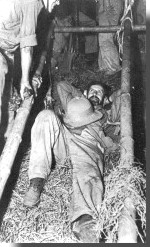 Added to these difficulties was another reason slowing the providing of men and defining precise objectives for them. Up to February of 1944 indecision and a lack of trust reigned among the Allied high command as to proceeding with the offense into Burma. Chaing Kai-Shek refused several times to allow his Chinese forces to be used in Burma. There was conflict between the Americans and British over the resources and timing of the invasions of northwest Europe. Churchill, the British Chiefs of Staff, Mountbatten & Slim at one time or another were uncomfortable with the emphasis on northern Burma as the place where to conduct operations. With eyes on regaining the lost colonies further east, SEAC half-expected action to be cancelled, and instead planned for assaults into southern Burma and Sumatra. The U.S. was suspicious of British intentions to conduct any operation, and in February President Roosevelt sent a stern cable to Churchill reminding him of the Quebec promises. The
plans and counter-plans
formulated then discarded meant men & equipment were slow in arriving to fulfill Wingate’s needs. Not privy to these top-level Allied strategic disputes,
Wingate was furious
at the lack of commitment. Slim had reason for his reluctance to part with troops. In early 1944 intelligence was confirming signs of a Japanese move into India.
Added to these difficulties was another reason slowing the providing of men and defining precise objectives for them. Up to February of 1944 indecision and a lack of trust reigned among the Allied high command as to proceeding with the offense into Burma. Chaing Kai-Shek refused several times to allow his Chinese forces to be used in Burma. There was conflict between the Americans and British over the resources and timing of the invasions of northwest Europe. Churchill, the British Chiefs of Staff, Mountbatten & Slim at one time or another were uncomfortable with the emphasis on northern Burma as the place where to conduct operations. With eyes on regaining the lost colonies further east, SEAC half-expected action to be cancelled, and instead planned for assaults into southern Burma and Sumatra. The U.S. was suspicious of British intentions to conduct any operation, and in February President Roosevelt sent a stern cable to Churchill reminding him of the Quebec promises. The
plans and counter-plans
formulated then discarded meant men & equipment were slow in arriving to fulfill Wingate’s needs. Not privy to these top-level Allied strategic disputes,
Wingate was furious
at the lack of commitment. Slim had reason for his reluctance to part with troops. In early 1944 intelligence was confirming signs of a Japanese move into India.
The Indirect Gain
The 1943 Chindit mission had a tremendous impact upon the Japanese, inspiring them to change their strategy. The Japanese army commander in northern Burma, General Mutaguchi, was a division commander against the Chindits in 1943 and had difficulty contending with them. Now as the army commander, he was facing threats from three directions, from across the Chindwin, from Ledo into Hukawng Valley, and from the east from across the Salween. The seemingly impenetrable jungle & mountain of the Burma frontier was no longer seen as a secure flank for the defense of Burma. He reasoned he must attack before the British did again using long-range penetration on a massive scale. As he described, "To cope with this difficult situation I thought that the best policy would be to strike from our side, before the enemy started his counter-offensive, and I planned, if the campaign made this possible, to continue the attack into India...I must say that the motive leading to the above decision was the decisive step taken by General Wingate when he moved into Burma."17 Mutaguchi believed if a weak British force could cross the Chindwin and trackless, mountainous jungle terrain, a Japanese force could infiltrate from northern Burma in the dry season & strike into India. Confident of the Japanese Imperial Army's ability to encircle and defeat an enemy not held in high respect, he began planning to cross the Chindwin and seize the British logistics base of Imphal in eastern India and decisively defeat the British.
photo caption
Wingate with Colonels Allison and Cochran, commanders of the US air unit that would along with other air force units made Wingate's ideas feasible. Cochran was taken by Wingate and saw Wingate's control of his forces through radio as an extension of air tactics on the ground.
U.S. Air Force photo
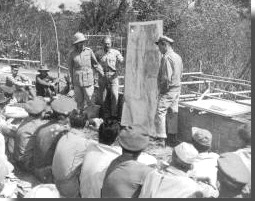
 The war was not going Japan's way and Tokyo was looking for victories. In January of 1944 Mutaguchi's plan was approved. He was to use 3 divisions to launch an offense in the remaining dry season beginning March of 1944 to capture the main British base of Imphal, and consolidate there to protect Burma. However he secretly planned to go further on & to seize the main Allied supply base further west at Dimaphur. This would sever communications between India & Upper Assam and the important airfields that serviced China with supplies over the Himalayas, thus forcing China to come to terms. And he hoped this could create political instability in India and compel a British withdraw. But he could only arrange for 20 days of supplies, including cattle, to be brought forward by his troops carrying them throuh the rough terrain lacking in roads. To make up for the logistical shortcomings and air force he was denied, it was planned to use captured supplies and transport taken at the prize of Imphal. The confident Mutaguchi was a strong believer in the
Samurai Code,
which as one of its tenets held that if one attacks with enough determination, speed and courage, then administrative problems could be overcome. With a feint attack to be launched in the south to divert British attention, Mutaguchi proclaimed he would achieve success after three weeks. The planned British offense into central Burma was halted when the Japanese were discovered to be preparing to launch theirs. General Slim's army began preparing to meet them on favorable ground around Imphal. He reasoned the Japanese army would be weakened and more vulnerable to counter-attack if they were first forced to fight with supply lines stretched over the tough terrain.
The war was not going Japan's way and Tokyo was looking for victories. In January of 1944 Mutaguchi's plan was approved. He was to use 3 divisions to launch an offense in the remaining dry season beginning March of 1944 to capture the main British base of Imphal, and consolidate there to protect Burma. However he secretly planned to go further on & to seize the main Allied supply base further west at Dimaphur. This would sever communications between India & Upper Assam and the important airfields that serviced China with supplies over the Himalayas, thus forcing China to come to terms. And he hoped this could create political instability in India and compel a British withdraw. But he could only arrange for 20 days of supplies, including cattle, to be brought forward by his troops carrying them throuh the rough terrain lacking in roads. To make up for the logistical shortcomings and air force he was denied, it was planned to use captured supplies and transport taken at the prize of Imphal. The confident Mutaguchi was a strong believer in the
Samurai Code,
which as one of its tenets held that if one attacks with enough determination, speed and courage, then administrative problems could be overcome. With a feint attack to be launched in the south to divert British attention, Mutaguchi proclaimed he would achieve success after three weeks. The planned British offense into central Burma was halted when the Japanese were discovered to be preparing to launch theirs. General Slim's army began preparing to meet them on favorable ground around Imphal. He reasoned the Japanese army would be weakened and more vulnerable to counter-attack if they were first forced to fight with supply lines stretched over the tough terrain.
Wingate conceived Long-Range Penetration as air & ground forces forcing a decisive result against the Japanese. His concept, "Using air mobility and air supply would, he argued, enable forces to establish a permanent presence in the enemy rear, deepening the main battle."19 With a large force, "Deep Penetration means the operations of regular columns of high caliber in the heart of the enemy war machine, engaging targets he is unable adequately to protect, and thus compelling him to alter his plans, thus causing a situation of which our own main forces are able to take advantage."20 As originally conceived the Chindits would remain light & self-contained, relying upon mobility & surprise to raid lines of communication & create blocks. He envisioned a block as a temporary base astride enemy supply lines, the location dependent upon the local geography and the duration upon the tactical situation. Wingate had foreseen a Japanese offense in January. He adjusted his plans accordingly with the notion the, "Only effectual answer to penetration seems to be counter penetration"21 An enemy offense would be to his force's advantage he thought, with Burma made more vulnerable with supply lines less protected & with more room for maneuver by the Chindits. With having to operate for some time deep in enemy territory, Wingate tried to balance the limitations of his force with the idea of fortified base positions, or Strongholds (from a Bible quote, "Turn you to the stronghold, ye prisoner of hope"). Located in difficult or remote terrain & thus inaccessible to enemy armor & towed artillery, they would be positioned near land flat enough for an airstrip for supply & medical evacuation. From these the Chindits could sortie forth to attack Japanese communications, returning for supply & rest. A battalion with artillery, wire & mines would defend. Support would come by 'floater columns' moving around the base ready to ambush any approaching enemy force, and from aircraft. Such defenses would force an enemy to attack in unfavorable conditions, making it too difficult to attack with anything below division strength.
Preparations
Wingate intensely trained his units. He, "drove himself and his staff hard, because he knew that you have to be hard, both mentally and physically, to beat such an enemy in such a country...He knew that his first duty to his men would be to see that they were well trained beforehand. He knew that the assurance of victory is the greatest gift you can give a soldier."24 Setting aside doubts over the future, in his speeches he tried to see to it his men were prepared, expressing confidence of the prospect of success and describing the importance of the new Chindit force. To Wingate nothing was impossible and though his standards were high his confidence and vision was inspiring. Stated one of his officers, "General Wingate was not an easy man to follow. By regular army standards, he was obviously eccentric, but he possessed that prized ability to inspire confidence in the minds of his subordinates."25 As one young officer in the audience at a lecture described, "He was the worst-dressed officer I have ever seen. The most remarkable thing about him were his eyes and his voice, which were as sharp as steel and with both of which he seemed to stab anyone to whom he was talking... There was something awe-inspiring in his certainty and his dogmatism, yet something which inspired the fullest confidence, so that one went away saying,' with him in command we cannot fail.'"26 Experienced officers from the first foray were given command positions, including Calvert and Fergusson who would each lead one of the 6 brigades with the rank of Brigadier-General. Wingate himself as a Major-General refused a higher rank when offered to him by Mountbatten, believing he should have to prove himself first. His ambition was, "to be the leader of such an expedition as would alter the whole tide of affairs in the most distressed and unhopeful British military theatre. If it was true that a great ambition drove him on, here, as elsewhere in his life, it was an ambition in which self played little part."27
photo caption
Gliders being marshaled. Combined training between ground & air units produced a mutual understanding of each others needs & capabilities, and creating Chindit trust in the U.S. air unit with the phrase uttered by one officer, "Any Place, Any Time, Any Where." (motto of today's USAF Special Operations Force)
Photograph courtesy of
Her Majesty's Stationary
Office, U.K.
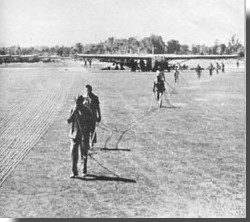

The forces for the second Chindit mission were trained and assembled by February of 1944. The Chindits would again operate in columns of roughly half-battalion size. Brigades were reorganized into 6-8 columns each of 7 enlarged platoons (4 infantry platoons with one each of demolitions-engineer, heavy weapons, reconnaissance), platoons of 4 squads. Most of the men for the columns were regular infantry with some artillery & recon formations converted to infantry. Burmese soldiers for intelligence purposes were also attached, along with specialists such as medical and signal. The heaviest weapons were the machine-guns & mortars in the weapons platoons, with each planned stronghold getting several artillery & anti-aircraft pieces. The 100 odd mules with each column again carried the heavy supplies such as the radios, mortars & ammunition. Together the force numbered close to 23,000 men.28 Attached to each column were RAF signals section with pilots and signalmen for directing supply drops & close air support. Dedicated air support was available due to the presence of the U.S. Army Air Force No.1 Air Commando, led by Colonel Cochran. Created from the promise at Quebec, it was assigned to work directly with the Chindits as their heavy firepower & transport. The Chindits now had direct access to 24 C-47 transports & 225 gliders for transport, 32 P-51 fighter-bombers & 12 B-25 medium bombers for close support, and 100 light planes for supply & casualty evacuation.29 Four other RAF & two USAAF transport squadrons were also made available for the initial landings, as was a bomber squadron. In contrast to the standard RAF procedure of briefing aircrew before missions and not being able to communicate with ground troops once in the air, the Chindits developed a new procedure. Via voice HF radio fitted in the aircraft, pilots in the air could talk to pilots in the ground columns, bringing in air strikes with greater flexibility & accuracy. Wingate expressed deep distress to close friends after the first Chindit mission over leaving behind the seriously wounded & sick. He said the memory ashamed him and would always remain with him. With the means to ensure the wounded would not be left behind from the light aircraft which could land almost anywhere, force morale would be high.
photo caption
Soldiers struggle to get mules aboard a C-47. To prevent braying giving away positions at night, vocal cords of the mules were surgically cut. They carried the 1086 radio set for RAF signals as well as the army type 22 set for tactical signals.
Photograph courtesy of
the Imperial War
Museum, London
Ready to Go
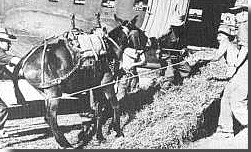 Given his official orders on February 4th, the 2nd Chindit mission, code-named Operation Thursday, was set to go. Wingate's first objective was to help Stilwell's force of two Chinese divisions & one American LRP regiment force advance into northwestern Burma down the Hukawng Valley. He would aim to prevent men and supplies from reaching the Japanese force (18th Division) opposing Stilwell, and to draw off enemy reinforcements. The target area was to be again the main supply route of the Myitkyina-Mandalay valley in northern Burma. With its flanks covered by forest-covered ridges and hills forcing supplies to the north to travel by the defined railroad and rough roads, the narrow valley was a vulnerable supply line. Secondly, Wingate was to create a favorable situation for the advance of the Chinese force across the Salween River into northeastern Burma. His last objective was to inflict the maximum mount of damage on Japanese forces in northern Burma. Wingate was counting on the Japanese command being fixated on its own advance and hesitant to withdraw forces against an unknown Allied threat, so assisting the speed of his early movements. While charged with aiding the advance into northern Burma, Wingate nurtured a private ambition. If the situation developed he intended to insert some of his reserve brigades to operate south of Indaw to the Chindwin against the supply lines of the Japanese force driving against India.
Given his official orders on February 4th, the 2nd Chindit mission, code-named Operation Thursday, was set to go. Wingate's first objective was to help Stilwell's force of two Chinese divisions & one American LRP regiment force advance into northwestern Burma down the Hukawng Valley. He would aim to prevent men and supplies from reaching the Japanese force (18th Division) opposing Stilwell, and to draw off enemy reinforcements. The target area was to be again the main supply route of the Myitkyina-Mandalay valley in northern Burma. With its flanks covered by forest-covered ridges and hills forcing supplies to the north to travel by the defined railroad and rough roads, the narrow valley was a vulnerable supply line. Secondly, Wingate was to create a favorable situation for the advance of the Chinese force across the Salween River into northeastern Burma. His last objective was to inflict the maximum mount of damage on Japanese forces in northern Burma. Wingate was counting on the Japanese command being fixated on its own advance and hesitant to withdraw forces against an unknown Allied threat, so assisting the speed of his early movements. While charged with aiding the advance into northern Burma, Wingate nurtured a private ambition. If the situation developed he intended to insert some of his reserve brigades to operate south of Indaw to the Chindwin against the supply lines of the Japanese force driving against India.
Three brigades would go in initially, the others to relieve them after 90 days. Calvert's 77th Brigade was to land first & was assigned the principal task of bottling up the railway & nearby roads in the Myitkyina-Mandalay valley. It would operate north of the important rail & road junction town of Indaw. 111th Brigade would operate south of Indaw, interdicting Japanese forces that might reach Calvert from the south. Using gliders in the first wave, half of Calvert's 77th brigade would go into landing zone Broadway, half to landing zone Piccadilly. 111th Brigade a few days later would fly in along with a force allotted for a mission further east, into the 3rd landing zone, Chowringhee. Broadway & Piccadilly were east of the railway valley & west of the Irrawaddy River, while Chowringhee was further south on the east side of the river. The landing zones themselves were open paddy & scrub land in areas with streams, surrounded by forest. American engineers would construct airstrips to enable the rest of the units to be flown in by transport aircraft, and bringing artillery for the strongholds & pack animals. A stream of cargo planes would ensure supply while lighter aircraft would be available to evacuate the wounded & provide forward supply. Fergusson's 16th Brigade would operate in the area west & south of Indaw to prevent the movement of reinforcements, hopefully seizing the town. Starting from Stilwell's flank in February before the others, it would cross the Chindwin to infiltrate through hills and forest towards Indaw. Both 16th & 111th would also be in position to interdict the northern supply lines of the Japanese forces advancing into India. All three brigades would establish a stronghold with an airstrip. Finally, a force of 2 columns with a small unit would operate east of 77th Brigade between the Irrawaddy’s branch, the Schweli River, and the Chinese border. They were tasked with interdicting the secondary supply route of the Lashio-Myitkyina road to the Japanese 18th Division, and the line to the Japanese 53rd Division facing the Salween.
photo caption
Men work to get mules into the Chindwin. It would take a month to reach the river through terrain described by Fergusson as, "nightmare country."34 Asked by Fergusson if the the rumor that he would offer help to the Jews after the war was true, Wingate said he wouldn't be surprised.
Photograph courtesy of
the Imperial War
Museum, London
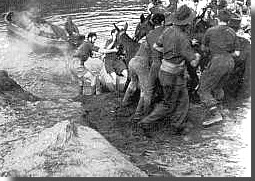
 In preparation for their main offensive, in February the Japanese launched the diversionary attack in the south to draw off British reserves. The British forces cautiously advancing into the Arakan were driven back and encircled. But they held with the aid of air supply the, "first time a British force had met, held and decisively defeated a major Japanese attack."30 On the central front the British was preparing to meet the Japanese near Imphal. In the north from the town of Ledo in India, Stilwell's forces began a sluggish advance into the Hukawng Valley in northwest Burma, a large force of road engineers working in their wake. Also from Ledo on February 5th Fergusson's 16th Brigade began their
difficult march,
in, first having to cross 70 miles of mountain ranges and deep valleys to reach the Chindwin. They men marched up and down muddy mountainsides 4-6,000 feet high and through dense forests in which, "From the moment we started up the Road until we came into the Chindwin Valley, not a day passed without rain: steady, solid, cold and merciless."32 At month’s end Fergusson reached the Chindwin, and on March 2 Wingate flew in to visit him. The crossing of the Chindwin was efficient and finished in a few days due to Fergusson's emphasis of this during training & gliders bringing in assault boats. The landing of the other two brigades was set for a full moon forecast in early March. Force morale was high, "the enthusiasm of Colonel Cochran and his airmen too was infectious to a degree and this helped to build the high morale, both at force headquarters and in the brigades. All felt a sense of impending adventure and had confidence in the future."33 On March 6th the Japanese forces began their drive towards Imphal & Kohima. The previous night the Chindit fly-in had begun.
In preparation for their main offensive, in February the Japanese launched the diversionary attack in the south to draw off British reserves. The British forces cautiously advancing into the Arakan were driven back and encircled. But they held with the aid of air supply the, "first time a British force had met, held and decisively defeated a major Japanese attack."30 On the central front the British was preparing to meet the Japanese near Imphal. In the north from the town of Ledo in India, Stilwell's forces began a sluggish advance into the Hukawng Valley in northwest Burma, a large force of road engineers working in their wake. Also from Ledo on February 5th Fergusson's 16th Brigade began their
difficult march,
in, first having to cross 70 miles of mountain ranges and deep valleys to reach the Chindwin. They men marched up and down muddy mountainsides 4-6,000 feet high and through dense forests in which, "From the moment we started up the Road until we came into the Chindwin Valley, not a day passed without rain: steady, solid, cold and merciless."32 At month’s end Fergusson reached the Chindwin, and on March 2 Wingate flew in to visit him. The crossing of the Chindwin was efficient and finished in a few days due to Fergusson's emphasis of this during training & gliders bringing in assault boats. The landing of the other two brigades was set for a full moon forecast in early March. Force morale was high, "the enthusiasm of Colonel Cochran and his airmen too was infectious to a degree and this helped to build the high morale, both at force headquarters and in the brigades. All felt a sense of impending adventure and had confidence in the future."33 On March 6th the Japanese forces began their drive towards Imphal & Kohima. The previous night the Chindit fly-in had begun.
1. Winston Churchill, The Second World War, Vol.V: Closing The Ring (Boston: Houghton Mifflin, 1951), 58.
2. Trevor Royle, Orde Wingate Irregular Soldier (London: Weidenfeld & Nicolson, 1995), 266.
3. Christopher Sykes, Orde Wingate
(New York: World Publishing Company, 1959), 455.
4. Sykes, 456.
5. Royle, 265.
6. Donald Mosher (ed), World War II: China-Burma-India (New York: Time-Life Books, 1978), 99.
7. Minutes of Combined Chiefs of Staff Quadrant Conference in Derek Tulloch, Wingate In War And Peace (London: History Book Club, 1972), 125.
8. Tulloch, 123.
9. Sykes, 471.
10. Peter Mead, Orde Wingate And The Historians (Devon: Merlin Books, 1987), 88.
11. Shelford Bidwell, The Chindit War (New York: MacMillan Publishing, 1979), 41.
12. Tulloch, 114.
13. Sir Robert Thompson, Make For The Hills (London: Leo Cooper, 1989), 71.
14. Romanus & Sunderland in Tulloch, 111.
15. Philip Ziegler, Mountbatten (New York: Alfred Knopf, 1985), 277.
16. Ziegler, 275.
17. Tulloch, 92.
18. Arthur Swinson, Four Samurai (London: Hutchinson, 1968), 17.
19. Simon Anglim, "Orde Wingate and the Theory Behind the Chindit Operations: Some Recent Findings," RUSI Journal, Vol. 147, No.2 (April, 2002), 96.
20. Tulloch, 51.
21. Thompson, 45.
22. Sykes, 487.
23. Royle, 297.
24. Michael Calvert, Prisoner of Hope
(London: Jonathan Cape, 1952), 86.
25. Royle, 278.
26. Bidwell, 62-3.
27. Sykes, 407.
28. Ibid, 484.
29. Louis Allen, Burma, The Longest War (New York: St. Martin's Press, 1984), 319.
30. Field Marshall Viscount Slim, Defeat Into Victory (London: Cassell, 1956), 246.
31. Bernard Fergusson, The Wild Green Earth (London: Collins Publishing, 1946), 48-9.
32. Fergusson, 35.
33. Tulloch, 148.
34. Fergusson, 21.
